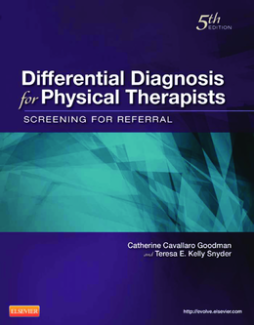
BOOK
Differential Diagnosis for Physical Therapists- E-Book
Catherine C. Goodman | Teresa Kelly Snyder
(2013)
Additional Information
Book Details
Abstract
Following the standards for competency established by the American Physical Therapy Association (APTA) related to conducting a screening examination, Differential Diagnosis for Physical Therapists, 5th Edition gives you a consistent way to screen for systemic diseases and medical conditions that can mimic neuromuscular and musculoskeletal problems. This comprehensive text centers on a 5-step screening model that covers past medical history, risk factor assessment, clinical presentation, associated signs and symptoms, and review of symptoms for each client.
- 5-Step screening model for differential diagnosis includes past medical history, risk factor assessment, clinical presentation, associated signs and symptoms, and review of symptoms.
- Systems-based approach to the physical therapy screening interview provides a consistent way to screen for systemic disease and medical conditions that can mimic neuromuscular and musculoskeletal problems.
- Three sections of content present material in a logical way that covers:
- An introduction to the screening process
- Viscerogenic causes of neuromusculoskeletal pain and dysfunction
- System origins of neuromusculoskeletal pain and dysfunction
- Cognitive processing and reasoning orientation approach encourages you to gather and analyze data, pose and solve problems, infer, hypothesize, and make clinical judgments.
- Case examples and case studies give real-world examples of hot to integrate screening information into the diagnosis process.
- Screening tools in the book and on the Evolve companion website feature forms and checklists used in professional practice.
- Introductory information on medical screening concepts set the stage for how screening is presented in the rest of the book.
- Reference values for common clinical laboratory tests offer easy access to pertinent information references in a screening exam.
- Red flag histories, risk factors, clinical presentation, signs and symptoms, helpful screening clues, and guidelines for referral bring your attention to the important information a therapist needs to be aware of during the screening process.
- NEW! Full-color design, photos, and illustrations clearly demonstrate pathologies and processes.
- NEW and UPDATED! Evolve resources include printable screening tools and checklists, practice test questions, and more to enhance your learning.
- NEW! Hot topics keep you informed on rehabbing patients in the dawn or more current surgeries.
